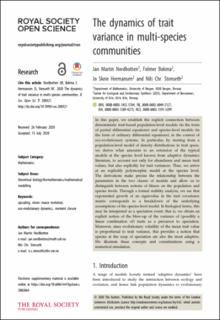| dc.contributor.author | Nordbotten, Jan Martin | |
| dc.contributor.author | Bokma, Folmer | |
| dc.contributor.author | Hermansen, Jo Skeie | |
| dc.contributor.author | Stenseth, Nils Christian | |
| dc.date.accessioned | 2021-05-06T14:14:26Z | |
| dc.date.available | 2021-05-06T14:14:26Z | |
| dc.date.created | 2020-10-09T19:50:23Z | |
| dc.date.issued | 2020 | |
| dc.Published | Royal Society Open Science. 2020, 7:200321 (8), 1-20. | |
| dc.identifier.issn | 2054-5703 | |
| dc.identifier.uri | https://hdl.handle.net/11250/2754015 | |
| dc.description.abstract | In this paper, we establish the explicit connection between deterministic trait-based population-level models (in the form of partial differential equations) and species-level models (in the form of ordinary differential equations), in the context of eco-evolutionary systems. In particular, by starting from a population-level model of density distributions in trait space, we derive what amounts to an extension of the typical models at the species level known from adaptive dynamics literature, to account not only for abundance and mean trait values, but also explicitly for trait variances. Thus, we arrive at an explicitly polymorphic model at the species level. The derivations make precise the relationship between the parameters in the two classes of models and allow us to distinguish between notions of fitness on the population and species levels. Through a formal stability analysis, we see that exponential growth of an eigenvalue in the trait covariance matrix corresponds to a breakdown of the underlying assumptions of the species-level model. In biological terms, this may be interpreted as a speciation event: that is, we obtain an explicit notion of the blow-up of the variance of (possibly a linear combination of) traits as a precursor to speciation. Moreover, since evolutionary volatility of the mean trait value is proportional to trait variance, this provides a notion that species at the cusp of speciation are also the most adaptive. We illustrate these concepts and considerations using a numerical simulation. | en_US |
| dc.language.iso | eng | en_US |
| dc.publisher | The Royal Society Publishing | en_US |
| dc.rights | Navngivelse 4.0 Internasjonal | * |
| dc.rights.uri | http://creativecommons.org/licenses/by/4.0/deed.no | * |
| dc.title | The dynamics of trait variance in multi-species communities: Multi-species trait variance dynamics | en_US |
| dc.type | Journal article | en_US |
| dc.type | Peer reviewed | en_US |
| dc.description.version | publishedVersion | en_US |
| dc.rights.holder | Copyright 2020 the authors. | en_US |
| dc.source.articlenumber | 200321 | en_US |
| cristin.ispublished | true | |
| cristin.fulltext | original | |
| cristin.qualitycode | 1 | |
| dc.identifier.doi | https://doi.org/10.1098/rsos.200321 | |
| dc.identifier.cristin | 1838588 | |
| dc.source.journal | Royal Society Open Science | en_US |
| dc.source.40 | 7:200321 | |
| dc.source.14 | 8 | |
| dc.identifier.citation | Royal Society Open Science. 2020, 7 (8), 200321. | en_US |
| dc.source.volume | 7 | en_US |
| dc.source.issue | 8 | en_US |

